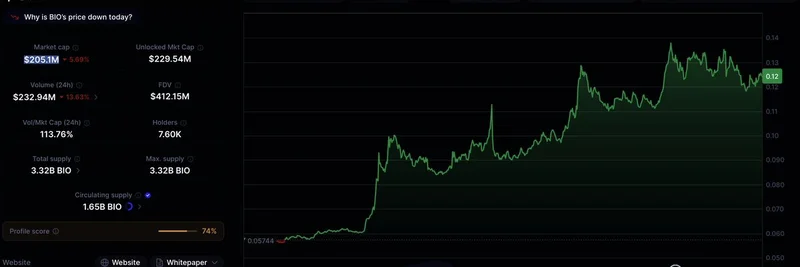In the fast-paced world of crypto, where tokens can skyrocket overnight, it's crucial to look beyond the hype. Recently, a tweet from Pine Analytics caught our eye, highlighting some red flags around Bio Protocol (BIO), a platform that's been making waves in the Decentralized Science (DeSci) space.
For those new to the term, DeSci is all about using blockchain to democratize scientific research, funding, and collaboration—think DAOs meets biotech. Bio Protocol fits right in as a curation and liquidity protocol that powers a launchpad for BioDAOs, which are essentially tokenized research and development networks. According to their official site, the platform enables communities to launch new BioDAOs through a three-phase process: curation, fundraising, and liquidity provisioning. It's designed to connect biotech with decentralized networks, and it even launched on Binance Launchpool back in late 2024 as an ERC-20 token.
But here's where things get interesting—and potentially worrisome. Pine Analytics pointed out that BIO has surged over 100% in just a week, pushing its fully diluted valuation (FDV) above $400 million. FDV, for the uninitiated, is a metric that calculates a token's market cap if all possible tokens were in circulation—it's like peeking at the project's total worth at current prices. With 12 projects already launched on their pad, you'd think this pump signals strong momentum. Yet, the analyst calls it "frothy" and "couldn’t be more bearish," suggesting the gains might be unsustainable.
Looking at the chart shared in the tweet (courtesy of CoinMarketCap), BIO's price climbed from around $0.07 to $0.12 in a short span, with a market cap hovering at $205 million and an unlocked market cap of nearly $230 million. The circulating supply is about 1.65 billion out of a max 3.32 billion tokens, which explains the high FDV. But why the bearish vibe? The key phrase in the tweet is "No Runners"—which seems to imply that despite launching 12 projects, none have really taken off or become "runners" in the market sense, meaning successful, high-performing ventures. In crypto slang, a "runner" is a project that gains traction and delivers returns, and if Bio Protocol's launches are fizzling out, that doesn't bode well for the platform's long-term value.
This sentiment echoes in the replies. One user, @lexashizo, slammed it as having "the ugliest token design ever," with Pine Analytics agreeing 100%. Another commenter, @lonabila, warned that when numbers pump faster than fundamentals, it's time to tread carefully. It's a classic case of hype outpacing reality, especially in a sector like DeSci where real-world impact—think breakthroughs in biotech—takes time to materialize.
Bio Protocol isn't without its merits, though. Their V1 upgrade earlier this year introduced improved AI agents, new revenue streams, and expansions to chains like Solana and Base, as detailed in The Block's coverage. They've got a solid backing from Binance and aim to revolutionize how science is funded. But with token unlocks ongoing (they led releases in some weeks, per CryptoRank), increased supply could dilute value if adoption doesn't keep up.
For meme token enthusiasts following along at Meme Insider, this serves as a reminder: even in non-meme projects like BIO, pump-and-dump dynamics can mimic the wild rides we're used to. If you're eyeing DeSci plays, keep an eye on BioDAOs' actual progress—check out their docs for a list of launched projects and see if any are gaining real traction.
In the end, while BIO's surge might tempt FOMO buyers, the bearish analysis from pros like Pine Analytics suggests caution. Crypto markets are volatile, and overvalued FDVs without strong fundamentals often lead to corrections. Stay informed, DYOR (do your own research), and maybe wait for those "runners" to emerge before diving in.



